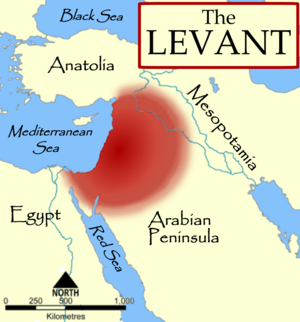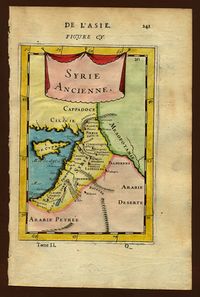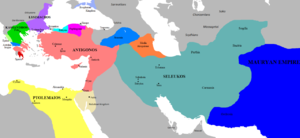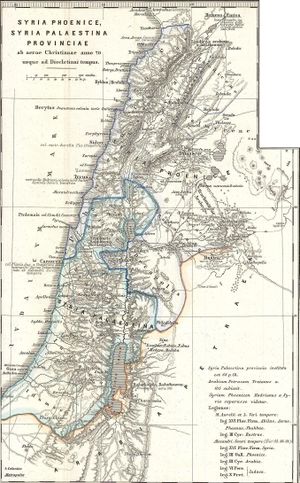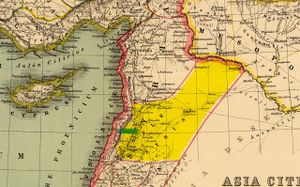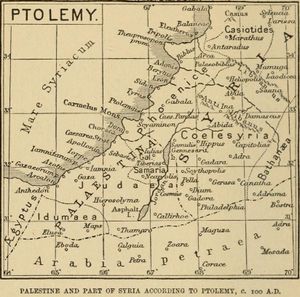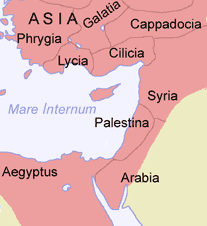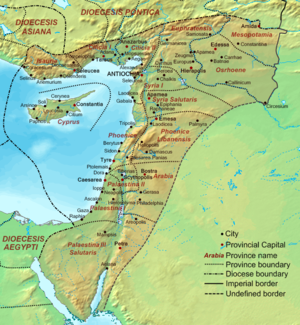سوريا الخاوية
| سوريا الخاوية Coele-Syria | |||||||||||||||||||||
|---|---|---|---|---|---|---|---|---|---|---|---|---|---|---|---|---|---|---|---|---|---|
| منطقة الامبراطورية المقدونية / المملكة الپطلمية / المملكة السلوقية | |||||||||||||||||||||
| 332 ق.م.–64 ق.م. | |||||||||||||||||||||
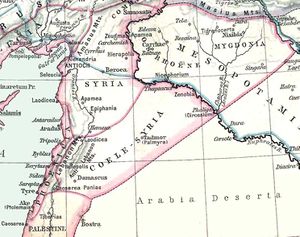 | |||||||||||||||||||||
| التاريخ | |||||||||||||||||||||
| العصر التاريخي | العصر الهلنستي | ||||||||||||||||||||
| 332 ق.م. | |||||||||||||||||||||
| 274 - 168 ق.م. | |||||||||||||||||||||
| 140 ق.م. | |||||||||||||||||||||
| 64 ق.م. | |||||||||||||||||||||
| |||||||||||||||||||||
سوريا الخاوية (باليونانية قديمة: Κοίλη Συρία؛ إنگليزية: Coele-Syria) كانت المنطقة من سوريا الجنوبيةالمتنازع عليها بين السلوقيين والبطالمة. وبدلاً من قصر التعبير اليوناني على سهل البقاع في لبنان، فعادة ما يـُستخدَم التعبير ليغطي كامل المنطقة جنوب النهر الكبير Eleutherus بما فيها فلسطين. وفي الواقع فإن ديودوروس الصقلي يشير إلى أن سوريا الخاوية تضم أيضاً السواحل الفلسطينية حتى جوپا Joppa جنوباً. التعبير الهليني Koile Syria الذي ظهر لأول مرة في كتاب أريان Anabasis (2.13.7) ونوقش على نطاق واسع ، يبدو أنه ببساطة تحريف للكلمة الآرامية كل، أي جميع"، مما يعني أن التعبير يشير إلى كل سوريا، وهو ما يؤيده النطاق الواسع للمعاني المقترحة. [1]
جنرال الإسكندر الأكبر بطليموس احتل لأول مرة سوريا الخاوية في 318 ق.م.. وعندما انضم بطليموس إلى التحالف ضد أنتيگون الأول الأعور في 313 ق.م. فإنه سارع بالانسحاب من سوريا الخاوية. وفي 312 انتصر سلوقس الأول نيكاتور على دمتريوس، ابن أنتيگونوس، في معركة غزة التي أتاحت لبطليموس مرة أخرى أن يحتل سوريا الخاوية.
. . . . . . . . . . . . . . . . . . . . . . . . . . . . . . . . . . . . . . . . . . . . . . . . . . . . . . . . . . . . . . . . . . . . . . . . . . . . . . . . . . . . . . . . . . . . . . . . . . . . . . . . . . . . . . . . . . . . . . . . . . . . . . . . . . . . . . . . . . . . . . . . . . . . . . . . . . . . . . . . . . . . . . . .
الاستخدام الرسمي
حسب پوليبيوس، فإن ضابطاً سابقاً في الامبراطورية الپطلمية اسمه پطليموس تراقيا، بعد أن قاتل في عام 217 ق.م. معركة رفح، فر إلى صف الملك السلوقي أنطيوخوس الثالث الأكبر. وقد أنعم أنطيوخوس عليه بلقب "ستراتيگوس و أرخيريوس سوريا الخاوية وفينيقيا". ويخمن بعض الدارسين أن ذلك اللقب ربما كان يستخدمه البطالمة قبل ذلك، إلا أنه لا يوجد دليل مباشر لدعم ذلك.[2]
الحروب السورية
المنطقة كانت موضع نزاع بين الأسرة السلوقية والأسرة الپطلمية أثناء الحروب السورية. فقد كان جنرال الإسكندر الأكبر، پطليموس هو أول من احتل سوريا الخاوية في 318 ق.م. إلا أنه حين انضم پطليموس للتحالف ضد أنتيگون الأول الأعور في 313 ق.م.، فإنه سرعان ما انسحب من سوريا الخاوية. وفي 312 ق.م. انتصر سلوقس الأول نيكاتور على دمتريوس، ابن أنتيگون، في معركة غزة مما سمح لپطليموس مرة أخرى أن يحتل سوريا الخاوية. إلا أنه انسحب مرة أخرى بعد بضعة أشهر، بعد أن انتصر دمتريوس في معركة على ذلك الجنرال ودخل أنتيگون سوريا عنوة حتى أنتيگونوسس، هذا النصر الوجيز مكـّن سلوقس من الهجوم السريع على بلاد بابل. وفي 302 ق.م.، انضم بطليموس إلى حلف جديد ضد أنتيگون وعاود احتلال سوريا الخاوية، ولكنه سرعان ما انسحب حين سمع تقريراً مكذوباً أن أنتيگون انتصر. ثم عاد حين انهزم أنتيگون في إپسوس في 301 ق.م. وكانت سوريا الخاوية من نصيب سلوقس، حسب قسمة المنتصرين في إبسوس، إذ لم يسهم بطليموس في النصر. ولكن بحكم تاريخ بطليموس السابق، فلم يُتوقع منه أن يقيم دفاعاً مستحكماً لسوريا الخاوية، ورضخ سلوقس لاحتلال بطليموس، ربما لأن سلوقس تذكر مساعدة بطليموس له في استعادة حكمه في بلاد بابل.
السلوقيون اللاحقون لم يكونوا بنفس القدر من التفهم، مما أسفر عن قرن الحروب السورية بين الپطالمة والسلوقيين. معركة پانيوم في 200 ق.م.، أثناء الحرب السورية الخامسة، كانت المعركة الحاسمة النهائية بين الجانبين في إنهاء سيطرة البطالمة على المنطقة. نزاعات الفترة 171-168 ق.م. على سوريا الخاوية، بين أنطيوخس الرابع المتجلي و پطليموس السادس فيلوماتور، هي محل نقاش في كتاب ليفي تاريخ روما منذ تأسيسها (في XLII. 29 and XLV. 11–12).
السيطرة السلوقية على منطقة يهودا بدأت في الانكماش باندلاع الثورة المكابية في 165 ق.م. مع انشغال القوات السلوقية في القتال على الجبهة الپارثية، فقد نجحت يهودا في تأمين استقلالها بحلول عام 140 ق.م. وبالرغم من محاولات الحكام السلوقيين لاستعادة الأراضي، فإن فتوحات پومپي في 64 ق.م. كانت ضربة حاسمة لتلك المحاولات، وأصبحت سوريا جزءاً من الجمهورية الرومانية.
سوريا العليا
تحت الملوك المقدونيين، كانت سوريا العليا (Syria Superior) مقسمة إلى أربع محافظات (tetrarchies) مسماة بأسماء عواصمها. Later in the Roman Pompeian era, the province was divided into nine districts.[3]
مسميات سوريا
بالحكم من أريان و The Anabasis of Alexander، مؤرخي الإسكندر الأكبر، as well as more ancient authors,[4] gave the name of Syria to all the country comprehended between the Tigris and the Mediterranean. The part to the east of the Euphrates, afterwards named Mesopotamia was called "Syria between the rivers;" that to the west was called by the general name Coele-Syria, and although Phoenicia and Palestine were sometimes separated from it. Yet, it was often comprehended as the whole country as far as Egypt.[5][6]
مسميات سوريا المتداولة في زمن قورش الأكبر ح. 530 ق.م. الرئيسي كل عبر النهر كل ما هو عبر النهر البديل Koile Syria ترجمة يونانية فاسدة
- حوالي 323 ق.م. Laomedon of Mytilene takes control of Coele-Syria (dissolving عبر النهر).[7]
- حوالي 323 ق.م. يسرد Periplus of Pseudo-Scylax عدة مدن على الساحل الفلسطيني (Dor, يافا، عسقلان، وعكا) الذين تم ضمهم إلى كويلى-سوريا.[8][9]
في حروب الديادوخي، Coele-Syria came under the control of أنتيگون الأول الأعور. Then in 301 ق.م.، Ptolemy I Soter exploited events surrounding the Battle of Ipsus to take control of the region. The victors at Ipsus finalized the breakup of Alexander's empire. Coele-Syria was allocated to Ptolemy's former ally Seleucus I Nicator, who—having been previously aided by Ptolemy—took no military action to gain control of the region. Their successors, however, became embroiled in a series of conflicts over this issue.[10]
- الحروب على سوريا الخاوية التي ذكرها پوليبيوس ح. 150 ق.م.[11]
- Ptolemy, marching on Pelusium, made his first halt at that city, and after picking up stragglers and serving out rations to his men moved on marching through the desert and skirting Mount Casius and the marshes called Barathra. Reaching the spot he was bound for on the fifth day he encamped at a distance of fifty stades from Raphia, (رفح الحالية على الحدود المصرية الفلسطينية، شمال Rhinocolara (العريش)) which is the first city of Coele-Syria on the Egyptian side after Rhinocolura.[12][13]
- حوالي 120 ق.م. في العمل المكتوب، 1 Maccabees ;
And king Demetrius made Apollonius his general, who was governor of Celesyria: and he gathered together a great army, and came to Jamnia.[14]
- حوالي 100 ق.م. في العمل المكتوب، 2 Maccabees ;
And when he could not overcome Onias, he went to Apollonius, the son of Tharseas, who at that time was governor of Celesyria, and Phenicia.[15][16]
- حدود مصر، حسب ديودورس الصقلي ح. 50 ق.م.
- Having spoken of the three boundaries of Egypt, by which it is distinguished from the rest of the continent, we now proceed to the next. The fourth side is nearly surrounded with a vast sea, without any harbours, being a very long and tedious voyage, and very difficult to find any place of landing. For from Parcetonium in Africa, to Joppa in Cœlo-Syria, for the space almost of five thousand furlongs, there is not one safe harbour to be found, except Pharus.[17]
- حوالي 25 ق.م. Livy in his written work, The History of Rome ;
Antiochus was so incensed, ...He at once sent his fleet to Cyprus, and in the first days of spring set his army in motion for Egypt and advanced into Coelo-Syria. When near Rhinocolura he was met by envoys from Ptolemy, who ...begged him to say clearly what he wanted rather than to attack Ptolemy as an enemy—by force of arms—after previously being his friend.[18][19][20]
سوريا الخاوية ذاتها
Authors of the Roman period differ on the limits of Coele-Syria, some extending and others contracting them. The Geography of Strabo notes that Coele Syria Propria (Proper) is defined by the Libanus and Anti-libanus mountain ranges, running parallel to each other.[21] In the wars between the Ptolemies and the Seleucidæ, the name Cœle (or Hollow Syria) was applied to the whole of the southern portion of Syria, but under the Romans, it was confined to "Cœlesyria Proper" and variously included the district east of Anti-Libanus, about Damascus, and a portion of Palestine east of the Jordan river (possibly of: Trans-Jordan, Perea، أو ديكاپولس).[22]
مسميات سوريا التي يذكرها اسطرابون ح. 10 ق.م.[5][23] الرئيسية Cœlê-Syria & Seleucis-Syria & Phœnicia &c. &c. Cœlê-Syria ≠ Cœlo-Syrians[24] البديلة Cœlo-Syrians & Syrians & Phœnicians Similar to nomenclature given by Herodotus
- Circa 36 CE Philo of Alexandria in his written work, On the Life of Moses ;
When then [Moses] he received the supreme authority, with the good will of all his subjects, God himself being the regulator and approver of all his actions, he conducted his people as a colony into Phoenicia, and into the hollow Syria (Coele-syria), and Palestine, which was at that time called the land of the Canaanites, the borders of which country were three days' journey distant from Egypt.[25]
- Circa 43 CE Pomponius Mela in his written work, Description of the World ;
Syria holds a broad expanse of the littoral, as well as lands that extend rather broadly into the interior, and it is designated by different names in different places. For example, it is called Coele, Mesopotamia, Judaea, Commagene, and Sophene. It is Palestine at the point where Syria abuts the Arabs, then Phoenicia, and then—where it reaches Cilicia—Antiochia. [...] In Palestine, however, is Gaza, a mighty and well fortified city.[26]
The name Syria comes from the ancient Greek regional name for the Levantine colonies and colonial territories which they had established and which were "formerly comprehended as part of Assyria" (see Name of Syria).[27] Syria had an uncertain border to the northeast that Pliny the Elder describes as including from west to east; Commagene, Sophene, and Adiabene. In Pliny's time, Syria was administratively divided into a number of provinces with various degrees of autonomy under the Roman Empire, such as the Ityraei or Ituraei, who were a people of Coelo-Syria famous for shooting with a bow, [The wood of the trees called] "yews are bent into Ituraean bows".[28][29]
مسميات سوريا حسب پلني الأكبر ح.70 م[30] الرئيسي سوريا Syria المسميات المهملة: Palæstina, Judæa, Cœle, Phœnice البديل Syria & Phœnice
- حوالي 70 م Pliny the Elder in his written work, Natural History ;
Next to these countries on the coast is Syria, once the greatest of lands. It had a multitude of divisions with different names, the part adjacent to Arabia was previously known as Palestine (who's northernmost city was Caesarea, Plin. NH 5.69: "Caesarea ..finis Palastine") or Judaea or Cœle.[31][32]
- حوالي 100م يلاحظ يوسفوس في عمله المكتوب، Antiquities of the Jews، أنه في 46 ق.م. هيرود الأكبر was appointed as the "stratēgos" of Coele Syria, by the governor of Syria, Sextus Julius Caesar.[33][34] And he also writes ;
Antiochus made a friendship and league with Ptolemy, and gave him his daughter Cleopatra in marriage, and yielded up to him Cœle-Syria and Samaria and Judæa and Phœnicia by way of dowry.[35]
- Circa 125 CE The Roman emperor Hadrian promotes the city of Damascus to "Metropolis of Coele-Syria".[36][37]
- Circa 150 CE Appian in his written work, Roman History ;
Intending to write the history of the Romans, I have deemed it necessary to begin with the boundaries of the nations under their sway.... Here turning our course and passing round, we take in Palestine-Syria, and beyond it a part of Arabia. The Phoenicians hold the country next to Palestine on the sea, and beyond the Phoenician territory are Coele-Syria, and the parts stretching from the sea as far inland as the river Euphrates, namely Palmyra and the sandy country round about, extending even to the Euphrates itself.[38]
The ديكاپولس was so called from its ten cities enumerated by Pliny. And it should be noted, that what Pliny calls ديكاپولس, Ptolomy makes his Cœle-Syria; and the Cœle-Syria of Pliny, is that part of Syria about Aleppo.[39][40]
- هليوپوليس
- Abila which is called Lysinia (Abila Lysanios)
- Saana
- Ina
- Samulis (Samoulis)
- Abida
- Capitolias
- Adra
- Canatha
. . . . . . . . . . . . . . . . . . . . . . . . . . . . . . . . . . . . . . . . . . . . . . . . . . . . . . . . . . . . . . . . . . . . . . . . . . . . . . . . . . . . . . . . . . . . . . . . . . . . . . . . . . . . . . . . . . . . . . . . . . . . . . . . . . . . . . . . . . . . . . . . . . . . . . . . . . . . . . . . . . . . . . . .
مقاطعة سوريا الخاوية
The governor of Syria retained the civil administration of the whole large province undiminished, and held for long alone in all Asia a command of the first rank. It was only in the course of the second century that a diminution of his prerogatives occurred, when Hadrian took one of the four legions from the governor of Syria and handed it over to the governor of Palestine. It was Severus who at length withdrew the first place in the Roman military hierarchy from the Syrian governor. After having subdued the province —which had wished at that time to make Niger emperor, as it had formerly done with its governor Vespasian —amidst resistance from the capital Antioch in particular, he ordained its partition into a northern and a southern half, and gave to the governor of the former, which was called Coele-Syria, two legions, to the governor of the latter, the province of Syro-Phoenicia, one [legion].[44]
مسميات سوريا المعطاة في زمن سپتيميوس سڤروس ح.200 م[45][46][47] سوريا Syria Provincia Syria Coele Syria Coele ≠ Cœlê-Syria ≠ Cœlo-Syrians فينيقيا Phoenice Provincia Syria Phoenice فلسطين Provincia Syria Palæstina بلاد العرب Arabia Provincia Arabia Petraea
- حوالي 200 م. أولپيان، في الضرائب، المجلد الأول؛
There is also the colony of Laodicea, in Coele Syria, to which also the divine Severus granted the Italian Law on account of its services in the Civil War.[48]
- حدود 'أرض الميعاد' حسب جيروم ح. 400 م
يمكنك تحديد الأرض الموعودة لموسى من سفر الأعداد (إصحاح 34): بأنها يحدها من الجنوب أرض صحراوية تسمى سيناء، بين البحر الميت ومدينة قادش-برنع، [الواقعة في وادي عربة إلى الشرق] وتستمر إلى الغرب، حتى نهر مصر، الذي يصب في البحر المفتوح بالقرب من مدينة راينوكولارا؛ التي يحدها من الغرب البحر بطول سواحل فلسطين، فينيقيا، سوريا الخاوية وقيليقيا؛ as bounded on the north by the circle formed by the Taurus Mountains and Zephyrium and extending to Hamath, called Epiphany‑Syria; as bounded on the east by the city of Antioch Hippos and Lake Kinneret, now called بحيرة طبريا, and then the Jordan River which discharges into the salt sea, now called the Dead Sea.[49][50]
- حوالي 400 م ايوناپيوس في عمله المكتوب، Lives of Philosophers and Sophists ;
ليبانيوس (المتوفي 392 م) وُلِد في أنطاكية، عاصمة سوريا الخاوية كما تُسمى. تلك المدينة أسسها سلوقس الملقب نيكاتور.[51][52]
- عاصمة الامبراطورية السلوقية كانت أنطاكية (240–63 ق.م.)
- عاصمة سوريا الخاوية (المقاطعة الرومانية) كانت أنطاكية (200–600 م)
انظر أيضاً
- المملكة الهشمونية
- سوريا الرومانية
- المملكة الهيرودية
- Tetrarchy (Judea)
- يهودا (مقاطعة رومانية)
- سوريا الفلسطينية
الهامش
- ^ M. Sartre, "La Syrie creuse n'existe pas", in G. L. Gatier, et al. Géographie historique au proche-orient (1988:15-40), reviving the explanation offered by A. Schalit (1954), is reported by Robin Lane Fox, Travelling Heroes in the Epic Age of Homer( 2008, notes p378f): "the crux is solved".
- ^ خطأ استشهاد: وسم
<ref>غير صحيح؛ لا نص تم توفيره للمراجع المسماةGrabbe - ^ Society for the Diffusion of Useful Knowledge (Great Britain) (1842). Penny cyclopaedia of the Society for the diffusion of useful knowledge. C. Knight. pp. 476–.
Antient Divisions of Syria. –Under the Macedonian kings Syria was divided into four parts (tetrarchies), which were named after their capitals, Antioch, Seleuceia, Apamea, and Laodicea. Both the Greeks and the Romans called the northern portion of Syria, that is the whole country with the exception of Coele-Syria, Phoenice, and Palestine, by the name of Upper Syria (???, Syria Superior), to distinguish it from Coele Syria (???, that is, the Hollow Syria), which was the name given to the valley between the ridges of Libanus and Anti Libanus. Under the Romans the province was divided into nine districts: Cassiotis, Apamene, Chalcidice, Seleucis, Pieria, Commagene, Cyrrhestice, Chalybonitis, Palmyrene.(Image of p. 476 at Google Books)
{{cite book}}: External link in|quote= - ^ Besnier, Maurice (1914). Lexique de géographie ancienne. C. Klincksieck. pp. 222–223.
Image of p. 222 & p. 223 at Google Books
{{cite book}}: External link in|quote= - ^ أ ب Strabo (1889). The geography of Strabo. Bell. p. 161, note 1.
Strabo below, c. ii. § 21, refers to this ancient division, when he says that the name Coele-Syria extends to the whole country as far as Egypt and Arabia, although in its peculiar acceptation it applied only to the valley between Libanus and Antilibanus. (p. 161 at Google Books)
{{cite book}}: External link in|quote= - ^ VAN-WIJLICK, HENDRIKUS,ANTONIUS,MARGAR (2013). "Rome and Near Eastern Kingdoms and Principalities, 44-31 BCE: A Study of Political Relations During Civil War". Durham theses. Durham University: 90, note 29. Retrieved 13 June 2015.
The toponym "Coele Syria" (Κοίλη Συρία) has been used by ancient authors to designate various regions of the Levant. The term appeared for the first time in Greek language في بداية القرن الرابع ق.م.. Schalit (1954) 68-70 and Sartre (1988) 22, 26 among others have convincingly argued that at that time "Coele Syria" signified "the whole of Syria" from the Levantine coast in the west to the river Euphrates in the east covering the entire area of the old Achaemenid satrapy called kul ʿawar nahara ("everything beyond the river"). The word Κοίλη in this context does thus not mean "hollow" (κοῖλος), but "whole", and originates probably as a Greek transliteration from the Aramaic word "kul". As a result of administrative changes in the Levant during the following two and a half centuries, the toponym "Coele Syria" acquired additional narrower meanings, whereby it was used to refer to different parts of Syria. Throughout antiquity, though, it never seems to have lost its original meaning.
{{cite journal}}: CS1 maint: multiple names: authors list (link) - ^ Marcus Junianus Justinus; Yardley, J. C.; Wheatley, Pat (15 December 2011). Justin: Epitome of the Philippic History of Pompeius Trogus: Volume II: Books 13-15: The Successors to Alexander the Great. Clarendon Press. p. 91. ISBN 978-0-19-927759-9.
4. 12. Syria, was given to Laomedon of Mytilene. Curt. 10. 10. 2; Diod. 18. 3. 1; Arr. Succ. 1. 5; Dexippus, FGrH 100 F 8 §2. Syria here is Coele-Syria (Hollow Syria), in effect, the old Persian satrapy of Abarnahara ('the land beyond the river'; cf. Lehmann-Haupt §26; cf. §§129 ff). By strict definition, 'Hollow Syria' was the area between Lebanon and Antilebanon, though it came to represent the stretch from the Orontes to the Dead Sea. Strabo 16. 2. 16 C755 shows that it includes Damascus and the Jordan River, and that its northern and southern reaches are roughly parallel with Tripolis and Sidon respectively. Since the satrapy lists do not include a separate ruler for Phoenicia, we must conclude that Coele-Syria in the broad sense includes Phoenica as well; see also Pliny, HN 5. 13. 66-7.
- ^ Ameling, Walter; Cotton, Hannah M.; Eck, Werner (14 July 2014). South Coast: 2161-2648: A multi-lingual corpus of the inscriptions from Alexander to Muhammad. De Gruyter. p. 239, note 14. ISBN 978-3-11-033767-9.
The text is in bad shape and has been restored as follows: "Doros (Dor), a city of Sidonioi, <Ioppe (Jaffa), a city;> they say it was here that Androm<eda> was <ex>posed <to the monster. Aska>lon, a city of Tyrioi and a royal seat. Her<e is the boundary of Koile> (Hollow) Syria." (Shipley 2011, Pseudo-Skylax's Periplous, 104,3) Apparently the source lists the major cities on the Palestinian coast, apart from Gaza.
- ^ Shipley, Graham (2011). Pseudo-Skylax's Periplous: The Circumnavigation of the Inhabited World : Text, Translation and Commentary. Bristol Phoenix Press. ISBN 978-1-904675-82-2.
- ^ Kelly, Douglas; Londey, Peter (30 June 2016). Conflict in Ancient Greece and Rome: The Definitive Political, Social, and Military Encyclopedia [3 volumes]: The Definitive Political, Social, and Military Encyclopedia. ABC-CLIO. p. 981. ISBN 978-1-61069-020-1.
In 301 ق.م.، ضُمت يهودا إلى مقاطعة سوريا الخاوية البطلمية. ثم في 200 ق.م.، فتح السلوقيون سوريا الخاوية.
- ^ Shuckburgh, Evelyn. "Polybius, Histories". Follow PerseusDigLib on Twitter Perseus Digital Library. Tufts University. Retrieved 28 January 2015.
I shall tell how Antiochus (أنطيوخس الثالث الأكبر) and Ptolemy Philopator (Ptolemy IV Philopator) first quarreled and finally went to war with each other for the possession of Coele-Syria. (الحروب السورية 219–217 ق.م.) [...] (Now I come to) the disturbances in Egypt; (The attempted partition of the dominions of پطليموس الخامس المتجلي ح. 204) how, after the death of King Ptolemy (IV), Antiochus and Philip (Philip V of Macedon) entered into a compact for the partition of the dominions of that monarch's infant son, I shall describe their treacherous dealings. Philip laying hands upon; the islands of the Aegean and Caria and Samos. Antiochus upon; Coele-Syria and Phoenicia.
- ^ خطأ استشهاد: وسم
<ref>غير صحيح؛ لا نص تم توفيره للمراجع المسماةPolybius.ed.Hultsch.1889 - ^ Polybius; Walbank, Frank William (2011). The histories : in six volumes. 3. Books 5 - 8. Harvard University Press. pp. 212–215. ISBN 978-0-674-99658-8.
80. Ptolemy, marching on Pelusium, made his first halt at that city, and after picking up stragglers and serving out rations to his men moved on marching through the desert and skirting Mount Casius and the marshes called Barathra. Reaching the spot he was bound for on the fifth day he encamped at a distance of fifty stades from Raphia, (Modern Rafah at the border of Egypt and Israel, north of Rhinocolara (El Arish)) which is the first city of Coele-Syria on the Egyptian side after Rhinocolura. (p. 215 at Google Books)
{{cite book}}: External link in|quote= - ^ 1 Maccabees 10:69.
- ^ 2 Maccabees 3:5.
- ^ 2 Maccabees
- 3:8. So Heliodorus forthwith began his journey, under a colour of visiting the cities of Celesyria and Phenicia, but indeed to fulfil the king's purpose.
- 8:8. Then Philip seeing that the man gained ground by little and little, and that things for the most part succeeded prosperously with him, wrote to Ptolemee, the governor of Celesyria and Phenicia, to send aid to the king's affairs.
- ^ Diodorus (Siculus) (1814). The Historical Library of Diodorus the Sicilian: In Fifteen Books. To which are Added the Fragments of Diodorus, and Those Published by H. Valesius, I. Rhodomannus, and F. Ursinus. W. MʻDowall. pp. 36–.
Image of p. 36 at Google Books
{{cite book}}: External link in|quote= - ^ "Titus Livius (Livy), The History of Rome, Book 45,chapter 11". www.perseus.tufts.edu.
- ^ "LIVY - History of Rome". mcadams.posc.mu.edu.
- ^
- Liv. 33.19: During the previous summer Antiochus had reduced all the cities in Coelo-Syria which had been under Ptolemy's sway.
- Liv. Liv. 42.29: Antiochus was threatening Egypt, and in his contempt for the boy-king and his unenterprising guardians he thought that, by raising the question of Coelo-Syria, he would have a good pretext for war.
- ^ MacBean, Alexander; Johnson, Samuel (1773). "Coelesyria". A Dictionary of Ancient Geography: Explaining the Local Appellations in Sacred, Grecian, and Roman History; Exhibiting the Extent of Kingdoms, and Situations of Cities, &c. And Illustrating the Allusions and Epithets in the Greek and Roman Poets. The Whole Established by Proper Authorities, and Designed for the Use of Schools. G. Robinson. pp. 191–192.
Coelesyria, some write it conjoined as here, others, as the Greeks, Coele Syria, separate, which seems the juster way, because Pliny not only separates these words, but also simply says, Coele, an ancient inscription. Authors differ much in settling its limits, some extending, and others contracting, them too much: Strabo says, Coele Syria Propria is defined by Libanus and Anti-libanus, running parallel to each other. Now if we determine the limits of these two mountains, we shall go near to settle those of Coele Syria. They both begin a little above the sea; Libanus near Tripolis; chiefly against the spot called Dei Facies: Antilibanus at Sidon; but they terminate near the mountains of Arabia, above the territory of Damascus, and near the mountains of the Trachonitis, and there they terminate in other mountains, Strabo.
- ^ Pliny (the Elder) (1893). The Natural History of Pliny. H. G. Bohn. pp. 423, note 7.
Or the "Hollow" Syria. This was properly the name given, after the Macedonian conquest, to the great valley between the two great ranges of Mount Lebanon, in the south of Syria, bordering upon Phœnicia on the west, and Palestine on the south. In the wars between the Ptolemies and the Seleucidæ, the name was applied to the whole of the southern portion of Syria, which became subject for some time to the kings of Egypt; but under the Romans, it was confined to Cœlesyria proper with the district east of Anti-Libanus, about Damascus, and a portion of Palestine east of Jordan. (Image of p. 423 at Google Books)
{{cite book}}: External link in|quote= - ^ Strabo 16.2, Geographica
- ^ Richardson, Peter (1 January 1999). Herod: King of the Jews and Friend of the Romans. Fortress Press. p. 70, note 74. ISBN 978-1-4514-1594-0.
On Coele-Syria as a geographic designation, see Millar, Roman Near East, pp. 121-23, and .42 with bibliography cited there, including E. Bickerman, "La Coelé-Syria: Notes de géographie historique," RB 54 (1947): 256. The term floated; it did not have the connotations in antiquity that it now has. Most helpful is Strabo, Geog. 16.2.16-22: in 16-20 he discusses Coele-Syria proper, the area between the Lebanon and Anti-Lebanon Mountains; then in 21 he says the whole area between Seleucia (i.e., Syria) and Egypt-Arabia is called Coele-Syria, pointing out that "the country marked off by the Libanus and the Antilibanus is called by that name in a special sense" (see also 22). He is not confused but reports differing contemporary usages.
- ^ Philo (of Alexandria) (1855). "On the Life of Moses". The works of Philo Judaeus, the contemporary of Josephus. H. G. Bohn. p. 37.
When then [Moses] he received the supreme authority, with the good will of all his subjects, God himself being the regulator and approver of all his actions, he conducted his people as a colony into Phoenicia, and into the hollow Syria (Coele-syria), and Palestine, which was at that time called the land of the Canaanites, the borders of which country were three days' journey distant from Egypt. (p. 37 at Google Books)
{{cite book}}: External link in|quote= - ^ Pomponius Mela (1998). Frank E. Romer (ed.). Pomponius Mela's Description of the World. University of Michigan Press. p. 52. ISBN 0-472-08452-6.
62. Syria holds a broad expanse of the littoral, as well as lands that extend rather broadly into the interior, and it is designated by different names in different places. For example, it is called Coele, Mesopotamia, Judaea, Commagene, and Sophene. 63. It is Palestine at the point where Syria abuts the Arabs, then Phoenicia, and then—where it reaches Cilicia—Antiochia. [...] 64. In Palestine, however, is Gaza, a mighty and well fortified city.
- ^ (N.H. 5.66)
- ^ Verg. Georg. 2.458
- ^ Maro, Publius Vergilius (1755). Pub. Virgilii Maronis Georgicorum libri quatuor. The Georgicks of Vergil, with an Engl. By J. Martyn. p. 237.
Ityraeos taxi torquentur in arcus (Image of p. 237 at Google Books)
{{cite book}}: External link in|quote= - ^ Crane, Gregory. "Pliny the Elder, The Natural History John Bostock, M.D., F.R.S., H.T. Riley, Esq., B.A., Ed". Perseus Digital Library. Retrieved 25 January 2015.
Plin. Nat. 5.13, CHAP. 13. (12.)—SYRIA.
- ^ Asia is One Volume, with Thirty One Maps, Sanson's Tables, &c. as May be Seen in the Catalogue Thereof Annex'd to the Preface: 3. Nutt, John. 1712. p. 82.
Image of p. 82 at Google Books
{{cite book}}: External link in|quote= - ^ Pliny (the Elder.) (1848). Pliny's Natural History. In Thirty-seven Books. Club. p. 65.
Chapter XII. Syria, Palestine, Phœnicè. Near the Coast is Syria, a Region which in Times past was the chiefest of Lands, and distinguished by many Names. (Image of p. 65 at Google Books)
{{cite book}}: External link in|quote= - ^ "L 365 Josephus Jewish Antiquities IX: 12 13". archive.org.
Page Image
{{cite web}}: External link in|quote= - ^ Sir James William Redhouse (1887). A Tentative Chronological Synopsis of the History of Arabia and Its Neighbors: From B.C. 500,000(?) to A.D. 679. Trübner & Company. p. 19.
[Year] 46 [BCE] Herod (the Great) made governor of all Coele-Syria by Sextus Caesar, governor of Syria. (Image of p. 19 at Google Books)
{{cite book}}: External link in|quote= - ^ Flavius Josephus (1900). "IV. Antiquities of the Jews". The Works of Flavius Josephus. G. Bell and Sons. p. 323.
Antiochus made a friendship and league with Ptolemy, (Ptolemy V., Epiphanes 205-181 B.C.) and gave him his daughter Cleopatra in marriage, and yielded up to him Cœle-Syria and Samaria and Judæa and Phœnicia by way of dowry. (p. 323 at Google Books)
{{cite book}}: External link in|quote= - ^ Butcher, Kevin (2004). Coinage in Roman Syria: Northern Syria, 64 BC-AD 253. Royal Numismatic Society. p. 220. ISBN 978-0-901405-58-6.
- ^ Barclay Vincent Head (1887). "VII. Coele-Syria". Historia Numorum: A Manual of Greek Numismatics. p. 662.
- ^ Appian of Alexandria. "Preface of the Roman History". Livius.org. Retrieved 2011-12-11.
- ^ Hodgson, James; Derham, William; Mead, Richard; M. de Fontenelle (Bernard Le Bovier) (1727). Miscellanea Curiosa: Containing a Collection of Some of the Principal Phænomena in Nature, Accounted for by the Greatest Philosophers of this Age: Being the Most Valuable Discourses, Read and Delivered to the Royal Society, for the Advancement of Physical and Mathematical Knowledge. As Also a Collection of Curious Travels, Voyages, Antiquities, and Natural Histories of Countries; Presented to the Same Society. To which is Added, A Discourse of the Influence of the Sun and Moon on Human Bodies, &c. W. B. pp. 175–176.
ديكاپولس سميت كذلك لمدنها العشر اللائي ذكرهن پلني (lib. 5. 18.) And with them he reckons up among others, the Tetrarchy of Abila في نفس الديكاپولس : Which demonstrates the Abila ديكاپولس and Abila Lysaniæ to be the same Place. And tho'it cannot be denied, but that some of Pliny's ten Cities are not far distant from that near Jordan ; yet it doth not appear that ever this other had the Title of a Tetrarchy. Here it is to be observed, that what Pliny calls ديكاپولس, Ptolomy makes his Cœle-Syria ; and the Cœle-Syria of Pliny, is that Part of Syria about Aleppo, formerly call'd Chalcidene, Cyrrhistice, &c. (Image of p. 175 & p. 176 at Google Books)
{{cite book}}: External link in|quote= - ^ Cohen, Getzel M. (3 September 2006). The Hellenistic Settlements in Syria, the Red Sea Basin, and North Africa. University of California Press. p. 284, n. 1. ISBN 978-0-520-93102-2.
The problem of indicating precise ancient boundaries in Transjordan is difficult and complex and varies according to the time period under discussion. After the creation of the Roman province of Arabia في 106 م. Gerasa and Philadelphia were included in it. Nonetheless, Ptolemy—who was writing in the second century A.D. but did not record places by Roman provinces—described them as being in (the local geographical unit of) Coele Syria (5.14.18). Furthermore, Philadelphia continued to describe itself on its coins and in inscriptions of the second and third centuries A.D. as being a city of Coele Syria; see above, Philadelphia, n. 9. As for the boundaries of the new province, the northern frontier extended to a little beyond the north of Bostra and east; the western border ran somewhat east of the Jordan River valley and the Dead Sea but west of the city of Madaba (see M. Sartre, Trois ét., 17-75; Bowersock, ZPE5, [1970] 37-39; id., JRS61 [1971] 236-42; and especially id.. Arabia, 90-109). Gadara in Peraea is identified today with es-Salt near Tell Jadur, a place that is near the western boundary of the province of Arabia. And this region could have been described by Stephanos as being located "between Coele Syria and Arabia."
- ^ Claudius Ptolemy c.150 CE, The Geography, Book 5, Chapter XIV. Location of Syria (Fourth map of Asia)
- ^ Crane, Gregory. "Dictionary of Greek and Roman Geography (1854) William Smith, LLD, Ed". Perseus Digital Library. Tufts University. Retrieved 27 January 2015.
- ^ Carpenter, William (1836). The Biblical companion, or, An introduction to the reading and study of the holy Scriptures. p. 441.
Cœlosyria properly so called, lay between Libanus and Antilibanus, and was thence called Cœlosyria, or the Hollow Syria. Its principal cities were Heliopolis, Abila, Damascus and Laodicea. This geographer styles Abila Abila Lysaniœ, which agrees with St. Luke's division of the tetrarchy, chap iii. 1. From Abila, the neighbouring country took the name of Abilene. (Image of p. 441 at Google books)
{{cite book}}: External link in|quote= - ^ Mommsen, Theodor (1886). The History of Rome. R. Bentley. pp. 117–118.
The governor of Syria retained the civil administration of the whole large province undiminished, and held for long alone in all Asia a command of the first rank. [...] It was only in the course of the second century that a diminution of his prerogatives occurred, when Hadrian took one of the four legions from the governor of Syria and handed it over to the governor of Palestine. It was Severus who at length withdrew the first place in the Roman military hierarchy from the Syrian governor. After having subdued the province —which had wished at that time to make Niger emperor, as it had formerly done with its governor Vespasian —amidst resistance from the capital Antioch in particular, he ordained its partition into a northern and a southern half, and gave to the governor of the former, which was called Coele-Syria, two legions, to the governor of the latter, the province of Syro-Phoenicia, one [legion]. (Image of p. 117 & p. 118 at Google Books)
{{cite book}}: External link in|quote= - ^ Raleigh, Walter (1829). The Works of Sir Walter Ralegh, Kt: The history of the world. The University Press. pp. 217–. 3vGAz5Gs3JEC.
In Syria, taken largely, there were many small provinces as Coelesyria, which the Latins call Syria Cava, because it lay in that fruitful valley between the mountains of Libanus and Anti-Libanus, in which the famous cities of Antioch, Laodicea, Apamea, with many others were seated. (Raleigh 1829, p. 217, at Google Books)
{{cite book}}: External link in|quote= - ^ Lendering, Jona. "Provinces (Roman)". Livius. Livius.org. Retrieved 26 January 2015.
- ^ Cohen, Getzel M. (3 October 2006). The Hellenistic Settlements in Syria, the Red Sea Basin, and North Africa. University of California Press. p. 40, note 63. ISBN 978-0-520-93102-2.
In 194 A.D. The emperor Septimus Severus divided the province of Syria and made the northern part into a separate province called Coele Syria.
- ^ "Ulpian on Tyre's Juridical Status". www.livius.org. Retrieved 27 June 2016.
- ^ Sainte Bible expliquée et commentée, contenant le texte de la Vulgate. Bibl. Ecclésiastique. 1837. p. 41.
Quod si objeceris terram repromissionis dici, quae in Numerorum volumine continetur (Cap. 34), a meridie maris Salinarum per Sina et Cades-Barne, usque ad torrentem Aegypti, qui juxta Rhinocoruram mari magno influit; et ab occidente ipsum mare, quod Palaestinae, Phoenici, Syriae Coeles, Ciliciaeque pertenditur; ab aquilone Taurum montem et Zephyrium usque Emath, quae appellatur Epiphania Syriae; ad orientem vero per Antiochiam et lacum Cenereth, quae nunc Tiberias appellatur, et Jordanem, qui mari influit Salinarum, quod nunc Mortuum dicitur; (Image of p. 41 at Google Books)
{{cite book}}: External link in|quote= - ^ Hieronymus (1910). "Epistola CXXIX Ad Dardanum de Terra promissionis (al. 129; scripta circa annum 414ce)". Epistularum Pars III —Epistulae 121-154, p. 171 (The fifty-sixth volume of Corpus Scriptorum Ecclesiasticorum Latinorum also known as the Vienna Corpus: Letters Part 3, Containing letters 121-154 of St. Jerome.) Image of p. 171 at Archive.org
- ^ Philostratus (the Athenian); Eunapius (1922). Lives of the sophists. W. Heinemann. p. 519.
LIBANIUS was born at Antioch, the capital of Coele Syria as it is called. This city was founded by Seleucus surnamed Nicator. Libanius came of a noble family and ranked among the first citizens. (Image of p. 519 at Google Books)
{{cite book}}: External link in|quote= - ^ Pearse, Roger. "Eunapius, Lives of the Philosophers and Sophists (1921) pp.343-565. English translation". Early Church Fathers - Additional Texts. tertullian.org. Retrieved 19 December 2014.
Libanius was born at Antioch, the capital of Coele Syria as it is called. This city was founded by Seleucus surnamed Nicator
وصلات خارجية
- Bagnall, R.; J. Drinkwater; A. Esmonde-Cleary; W. Harris, R. Knapp; S. Mitchell; S. Parker; C. Wells; J. Wilkes; R. Talbert; M. E. Downs; M. Joann McDaniel; B. Z. Lund; T. Elliott; S. Gillies. "Places: 991407 (Syria Coele)". Pleiades. Retrieved March 8, 2012.
- Barclay Vincent Head (1887). "VII. Coele-Syria". Historia Numorum: A Manual of Greek Numismatics. p. 662.
| هذه بذرة مقالة عن الجمهورية العربية السورية تحتاج للنمو والتحسين، فساهم في إثرائها بالمشاركة في تحريرها. |
- Former country articles requiring maintenance
- Pages using infobox former subdivision with unknown parameters
- Articles containing Ancient Greek (to 1453)-language text
- Articles containing إنگليزية-language text
- Articles with hatnote templates targeting a nonexistent page
- تاريخ سوريا
- تاريخ فلسطين
- سلوقيون
- البطالمة
- سوريا الخاوية
- Seleucid Empire
- 4th century BC in Asia
- 3rd century BC in Asia
- 2nd century BC in Asia
- 1st century BC in Asia

